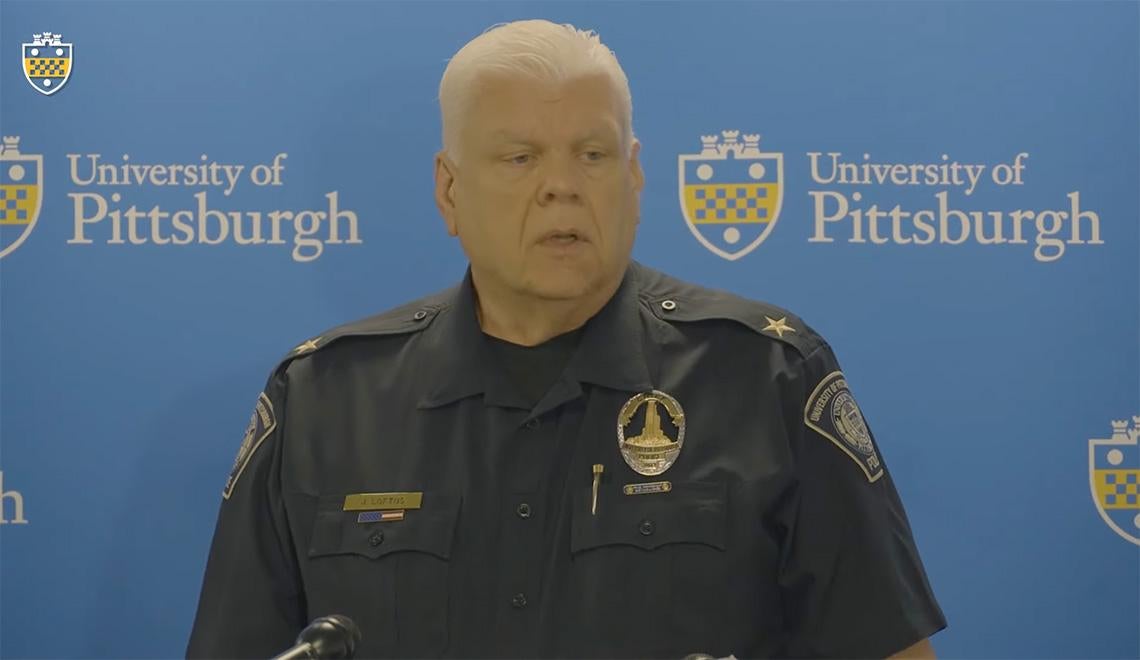
Subscribe to Pittwire Today
Get the most interesting and important stories from the University of Pittsburgh.Monday night, Pittsburgh Police received at least three calls falsely claiming an active killer situation at Pitt’s Hillman Library, prompting a response by both the City of Pittsburgh and Pitt Police. Minutes later, students in Mervis Hall called 911 to report concerns. Police quickly cleared both buildings and confirmed no active killer threats.
The next afternoon, University of Pittsburgh Police Chief James Loftus and Pittsburgh FBI Special Agent In Charge Scott Argiro answered pressing questions about campus safety in the wake of the incident, walking through the Pitt Police’s response and how they plan to handle such calls differently in the future.
What happened Monday night and when?
At 11:10 p.m. Monday, City of Pittsburgh police received the first of at least three calls claiming there was an active shooter at Pitt’s Hillman Library, which included background noises that sounded like gunfire. A call went out to both Pitt Police and City of Pittsburgh police at 11:14, and City of Pittsburgh officers arrived at the library one minute after that. In the process of entering the building, City of Pittsburgh police fired several gunshots at a glass door.
As an Emergency Notification Service (ENS) alert was about to go out to campus, Pitt Police received word of a second possible incident: a call from students in nearby academic building Mervis Hall who were concerned about noises they were hearing inside and around the building. After officers responded to that call and determined there was no danger at Mervis Hall, they sent out a message to campus at 12:37 a.m.
Why didn’t an ENS message go out to campus sooner, and why was the first message blank?
Pitt Police were preparing a message to campus when they received the second call about Mervis Hall. “It would have been, quite frankly irresponsible to put that message out, not knowing what was going on at Mervis Hall at that time,” said Loftus. “That was my call, it’s my responsibility. So we waited until Mervis was clear, and then an ENS message went out.”
Incidents like these calls prompt a barrage of information Pitt Police must sort through, including the initial call, calls from students and videos posted online. “I’m really proud of what we did on the operational side,” said Loftus. “My regret, and my responsibility, is that we didn't get the ENS message out as quickly as I feel we could have or should have.”
Contrary to social media posts indicating Duquesne University and Carnegie Mellon University released messages about the call before Pitt, neither university released a message informing their students of the threat, which was confined to Pitt’s campus.
The blank message was the result of an error using the emergency notification system program: The sender can type a message in one of two windows, one for short messages and one for long messages. When the Pitt Police sender composed a message that was too long, they deleted the text from the first window, resulting in a message that read only “Pitt E.N.S. Alert:”. When Pitt Police realized what had happened, they sent an updated message.

Why were doors in the Hillman Library locked during the incident?
Three doors were locked and chained, Loftus explained, because of ongoing construction in the building — these doors led to areas being prepared for construction and weren’t emergency exits, which was indicated with signs.
When students encountered these doors while evacuating the building, Loftus said, “They moved to other exits, they went with the flow. I’m not pandering to our student body, our student body did a great job.”
How will Pitt Police do a better job informing campus in the future?
Pitt Police are reviewing their communication processes to inform the campus community earlier, Loftus said. While they can’t send a message immediately when they’re notified of a call — in the first minutes after being notified they’re not yet sure whether there’s a real threat to campus — they may be able to send quicker messages notifying campus of possible threats.
“We’re working on some interim messaging, some things that we can do to steer people away from the area” without affecting police operations, Loftus said. “That’s my pledge, is we will do things like that in the future” in the case of active killer calls.
In incidents like these, Loftus added, “We have a clock running in our head — that we want to get this out as soon as possible, because we owe it to everybody.”
Are there similarities between this week’s calls and the similar malicious call at Central Catholic late last month?
While both the Central Catholic call and Monday’s involved disinformation about active killers, there were several differences between the two incidents. On Monday, Pittsburgh and Pitt police received three separate calls, while the Central Catholic incident involved only one. “How often do you see where there’s multiple calls, maybe from the same person, framing something?” Loftus said. “For the responding officers, they’re thinking — they should be thinking — ‘This is new, I’ve never experienced this before.’”
And the response force was much smaller Monday, Loftus said. While the response at Central Catholic involved hundreds of law enforcement personnel, “there were not as many people involved last night, and they were working their way through that search.”
It’s unclear whether there’s a connection between the two situations, Loftus said.
“These incidents have been occurring across the country,” he said, adding that he sees no indication they’ll stop or even slow down. “So what we will do is try to get better each time.”
[Here’s how your unit or group can participate in active killer training from Pitt Police.]
What’s being done to try to find the caller?
Although Pittsburgh Police were only able to determine a partial number for the caller, local police forces are working with the FBI to investigate the caller’s identity. “We’ll throw the full resources of the FBI at this investigation all the way through, and if we can establish a federal nexus, we’ll prosecute it,” said Argiro, the Pittsburgh FBI Special Agent in Charge, adding that the FBI has tools that can track calls even when technology is used to obfuscate their source.
What are Pitt Police doing to prepare campus for the threat of active killers?
åLoftus noted that Pitt Police have trained more than 4,000 people on Pitt’s campus to respond to active killers. Training typically happens in the buildings where Pitt community members spend their time, so the training can be adapted to that particular environment. “We will go anywhere and talk to anybody about active shooter and active killer training,” Loftus said.
Anyone interested can learn more on the Pitt Police website, which includes a video training, written guidelines and information for students, faculty or staff who wish to request a training.
Have these incidents changed how Pitt plans to handle security at commencement later this month?
Loftus confirmed these incidents are factoring into Pitt’s preparation for commencement celebrations. “Rest assured — we always have a good presence there — and there will be even a larger, more complete, comprehensive presence,” he said.
Photography by Johnathan Wright


